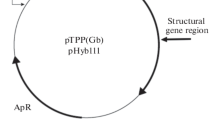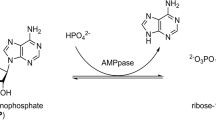Abstract
The quaternary structure of ATP-dependent phosphoenolpyruvate (PEP) carboxykinases is variable. Thus, the carboxykinases from Escherichia coli, Trypanosoma brucei, and Saccharomyces cerevisiae are monomer, homodimer, and homotetramer, respectively. In this work, we studied the effect of temperature on the stability of the enzyme activity of these three carboxykinases, and have found that it follows the order monomer > dimer > tetramer. The inactivation processes are first order with respect to active enzyme. The presence of substrates leads to an increase in the thermal stability of all three PEP carboxykinases. The protection effect of the substrates on the thermal inactivation of these enzymes suggests similarities in the substrate-bound form of these proteins. We propose that the higher structural complexity of some PEP carboxykinases could be related to the acquisition of properties of relevance in vivo.
Similar content being viewed by others
REFERENCES
Bazaes, S., Silva, R., Goldie, H., Cardemil, E., and Jabalquinto, A. M. (1993). J. Protein Chem. 12: 571–577.
Burnell, J. N. (1986). Aust. J. Plant Physiol. 13: 577–587.
Dunten, P., Belunis, C., Crowther, R., Hollfelder, K., Kammlott, U., Levin, W., et al. (2002). J. Mol. Biol. 316: 257–264.
Encinas, M. V., Evangelio, J. A., Andreu, J. M., Goldie, H., and Cardemil, E. (1998). Eur. J. Biochem. 255: 439–445.
Encinas, M. V., González-Nilo, F. D., Andreu, J. M., Alfonso, C., and Cardemil, E. (2002a). Int. J. Biochem. Cell Biol. 34: 645–656.
Encinas, M. V., González-Nilo, F. D., Goldie, H., and Cardemil, E. (2002b). Eur. J. Biochem. 269: 4960–4968.
Frieden, C., Jiang, N., Cistola, D. P. (1995) Biochemistry 34: 2724–2730.
Hanson, R. W., and Patel, Y. (1994). In: Meister, A. (ed.), Adv. Enzymol. Rel. Areas Mol. Biol. (Vol. 69), Wiley, New York, pp. 203–281.
Jabalquinto, A. M., Laivenieks, M., González-Nilo, F. D., Yévenes, A., Encinas, M. V., Zeikus, J. G., et al. (2002). J. Protein Chem. 21: 393–400.
Klotz, I. M., Darnall, D. W., and Langerman, N. R. (1975). In: Neurath, H., and Hill, R. L. (eds.), The Proteins (Vol. 1), Academic Press, New York, pp. 293–411.
Krautwurst, H., Bazaes, S., González, F. D., Jabalquinto, A. M., Frey, P. A., and Cardemil, E. (1998). Biochemistry 37: 6295–6302.
Llanos, L., Briones, R., Yévenes, A., González-Nilo, F. D., Frey, P. A., and Cardemil, E. (2001). FEBS Lett. 493: 1–5.
Matte, A., Goldie, H., Sweet, R. M., and Delbaere, L. T. J. (1996). J. Mol. Biol. 256: 126–143.
Matte, A., Tari, L. W., Goldie, H., and Delbaere, L. T. J. (1997). J. Biol. Chem. 272: 8105–8108.
Medina, V., Pontarollo, R., Glaeske, D., Table, H., and Goldie, H. (1990). J. Bacteriol. 172: 7151–7156.
Mei, G., Di Venere, A., Buganza, M., Vecchini, P., Rosato, N., and Finazzi-Agro, A. (1997). Biochemistry 36: 10917–10922.
Mukhopadhyay, B., Concar, E. M., and Wolfe, R. S. (2001). J. Biol. Chem. 276: 16137–16145.
Neet, K. E., and Timm, D. E. (1994). Protein Sci. 3: 2167–2174.
Stevens, J. M., Hornby, J. A. T., Armstrong, R. N., and Dirr, H. W. (1998). Biochemistry 37: 15534–15541.
Tari, L. W., Matte, A., Pugazhenthi, U., Goldie, H., and Delbaere, L. T. J. (1996). Nat. Struct. Biol. 3: 355–363.
Trapani, S., Linss, J., Goldenberg, S., Fischer, H., Craievich, A. F., and Oliva, G. (2001). J. Mol. Biol. 313: 1059–1072.
Traut, T. W. (1994). Crit. Rev. Biochem. Mol. Biol. 29: 125–163.
Urbina, J. A., and Avilan, L. (1989). Phytochemistry 28: 1349–1353.
Utter, M. F., and Kolenbrander, H. M. (1972). The Enzymes (3rd Ed., Vol. 6), Academic Press, New York, pp. 117–168.
Walker, R. P., Chen, Z.-H., Acheson, R. M., and Leegood, R. C. (2002). Plant Physiol. 128: 165–172.
Yévenes, A., and Cardemil, E. (2000). Biochimie 82: 123–127.
Author information
Authors and Affiliations
Rights and permissions
About this article
Cite this article
Ravanal, M.C., Goldie, H. & Cardemil, E. Thermal Stability of Phosphoenolpyruvate Carboxykinases from Escherichia coli, Trypanosoma brucei, and Saccharomyces cerevisiae. J Protein Chem 22, 311–315 (2003). https://doi.org/10.1023/A:1025306105105
Published:
Issue Date:
DOI: https://doi.org/10.1023/A:1025306105105




